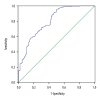Association of Lymphocyte-to-Monocyte Ratio with Poststroke Depression in Patients with Acute Ischemic Stroke
- PMID: 34021110
- PMCID: PMC8152443
- DOI: 10.12659/MSM.930076
Association of Lymphocyte-to-Monocyte Ratio with Poststroke Depression in Patients with Acute Ischemic Stroke
Abstract
BACKGROUND Poststroke depression (PSD) is a common neuropsychiatric disorder after stroke. The neuroinflammatory response exerts a vital effect in the development of PSD. Lymphocyte-to-monocyte ratio (LMR), a systemic inflammation biomarker, is associated with poor prognosis of acute ischemic stroke (AIS). The purpose of this study was to determine the association between LMR and PSD at 3 months. MATERIAL AND METHODS AIS patients (507) were included in this study. Patients were categorized into 3 tertiles and each tertile contains 169 patients: tertile1 (>4.85), tertile 2 (2.96 to 4.85), and tertile 3 (<2.96), based on LMR values and the numbers of patients. PSD was diagnosed with a 17-item Hamilton Depression Scale score of 8 or higher. RESULTS Patients (141; 27.8%) were diagnosed with PSD at 3-month follow-up. Patients in the PSD group presented with more severe stroke and lower LMR values (P<0.001). Decreased LMRs were independently associated with occurrence of PSD (middle tertile: odds ratio [OR] 1.823, P=0.037; lowest tertile: OR 3.024, P<0.001). A significant association of a lower LMR value with PSD severity was found (middle tertile: OR 1.883, P=0.031; lowest tertile: OR 2.633, P=0.001). The receiver operating characteristic curve indicates that the optimal threshold of LMR as a predictor for PSD was 3.14, which yielded a sensitivity of 72.4% and a specificity of 68.1%. CONCLUSIONS Decreased LMR is independently associated with PSD and increased PSD severity.
Conflict of interest statement
None.
Figures



Similar articles
-
High platelet-to-lymphocyte ratio are associated with post-stroke depression.J Affect Disord. 2019 Mar 1;246:105-111. doi: 10.1016/j.jad.2018.12.012. Epub 2018 Dec 10. J Affect Disord. 2019. PMID: 30578944
-
Serum Interleukin-33 is a Predictor of Depression in Patients with Acute Ischemic Stroke.Curr Neurovasc Res. 2020;17(5):719-724. doi: 10.2174/1567202617999210101223635. Curr Neurovasc Res. 2020. PMID: 33397261
-
Decreased Lymphocyte-to-Monocyte Ratio Predicts Poor Prognosis of Acute Ischemic Stroke Treated with Thrombolysis.Med Sci Monit. 2017 Dec 8;23:5826-5833. doi: 10.12659/msm.907919. Med Sci Monit. 2017. PMID: 29220346 Free PMC article.
-
Decreased Serum Brain-Derived Neurotrophic Factor May Indicate the Development of Poststroke Depression in Patients with Acute Ischemic Stroke: A Meta-Analysis.J Stroke Cerebrovasc Dis. 2018 Mar;27(3):709-715. doi: 10.1016/j.jstrokecerebrovasdis.2017.10.003. Epub 2017 Nov 8. J Stroke Cerebrovasc Dis. 2018. PMID: 29128330 Review.
-
Prognostic value of lymphocyte-to-monocyte ratio in acute ischemic stroke: a systematic review and meta-analysis.Front Neurol. 2025 May 7;16:1567112. doi: 10.3389/fneur.2025.1567112. eCollection 2025. Front Neurol. 2025. PMID: 40401022 Free PMC article. Review.
Cited by
-
Association between inflammatory markers and bone mineral density: a cross-sectional study from NHANES 2007-2010.J Orthop Surg Res. 2023 Apr 17;18(1):305. doi: 10.1186/s13018-023-03795-5. J Orthop Surg Res. 2023. PMID: 37069682 Free PMC article.
-
Body fluids biomarkers associated with prognosis of acute ischemic stroke: progress and prospects.Future Sci OA. 2024 May 20;10(1):FSO931. doi: 10.2144/fsoa-2023-0142. eCollection 2024. Future Sci OA. 2024. PMID: 38817358 Free PMC article. Review.
References
-
- Hackett ML, Pickles K. Part I: Frequency of depression after stroke: An updated systematic review and meta-analysis of observational studies. Int J Stroke. 2014;9:1017–25. - PubMed
-
- Cai W, Mueller C, Li YJ, et al. Post stroke depression and risk of stroke recurrence and mortality: A systematic review and meta-analysis. Ageing Res Rev. 2019;50:102–9. - PubMed
-
- Razmara A, Valle N, Markovic D, et al. Depression is associated with a higher risk of death among stroke survivors. J Stroke Cerebrovasc Dis. 2017;26:2870–79. - PubMed
MeSH terms
Substances
LinkOut - more resources
Full Text Sources
Other Literature Sources
Medical

